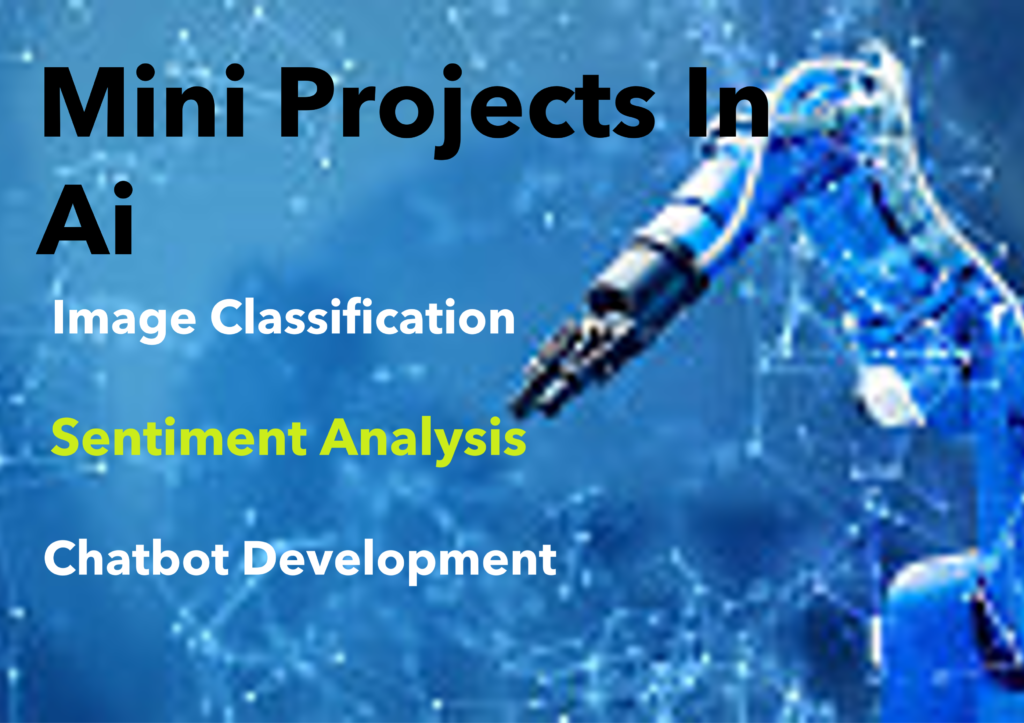
In the fast-evolving world of technology, hands-on experience is not just beneficial; it’s a career-defining necessity. For burgeoning tech and B.Tech students looking to delve into Artificial Intelligence (AI), embarking on mini projects provides a critical bridge from theoretical knowledge to practical application. In this detailed guide, we’ll explore several AI mini projects that can serve as invaluable tools for understanding AI principles and building your skills. From image classification to sentiment analysis, chatbot development, and recommendation systems, each project offers unique insights, challenges, and real-world relevance that will not only augment your understanding but also showcase your abilities to future employers.
Importance of Hands-On Learning in AI
Artificial Intelligence is a multidisciplinary field that marries computer science with various other fields. However, like many technical subjects, AI demands more than just passive learning—it requires active engagement and experimentation. Hands-on projects in AI offer a dynamic and direct educational experience that is simply unmatched by traditional methodologies. Through these projects, students encounter the complexities and variables that exist within AI models and data sets, which can significantly enhance understanding and skill development.
Benefits of Mini Projects for Tech Students
The benefits of engaging in mini projects as part of your tech education are numerous. They provide a structured environment for students to learn and experiment, promoting creativity and problem-solving skills. Mini projects also allow students to fail constructively, an important aspect of learning that is not always possible in traditional classroom settings. By working on such projects, students can learn to work independently, boost their self-confidence, and create tangible examples of their skills that can greatly improve their employability.
Now, let’s dive into four mini projects that exemplify the diverse possibilities within AI and offer a detailed roadmap to kick-start your hands-on AI journey.
Project 1: Image Classification
Image classification is an integral part of the AI module that focuses on teaching machines to recognize patterns. This project is excellent for understanding the fundamentals of machine learning (ML) and neural networks while also having a very visual and relatable outcome.
Setting Up Your Project
To begin, you will need to select a dataset. Websites like Kaggle offer numerous datasets that vary from the classification of animal species to distinguishing between different types of vehicles. Choose a dataset that interests you and aligns with your learning goals.
Developing the Model
Once you have the dataset, the next step is to build a model for classification. If you’re new to this, platforms like TensorFlow and Keras provide user-friendly interfaces to start with. Follow these steps:
- Preprocessing data: Reshape the images to a consistent format and normalize the pixel values.
- Building the model: Start with a simple convolutional neural network (CNN) architecture.
- Training the model: Use appropriate loss functions and optimizers to train your model.
Evaluating Your Model
After training your model, it’s crucial to evaluate its performance. Explore concepts like accuracy, precision, recall, and F1 score to understand how well your model classifies different images.
Experiencing Real-World Issues
During your project, you may encounter common issues, such as overfitting or underfitting, which provide an opportunity to learn about regularization techniques and data augmentation.
Sample Code and Resources
Here’s a sample code snippet using TensorFlow/Keras for image classification:
model = tf.keras.Sequential([ tf.keras.layers.Conv2D(32, (3,3), activation='relu', input_shape=(28, 28, 1)), tf.keras.layers.MaxPooling2D(2, 2), tf.keras.layers.Flatten(), tf.keras.layers.Dense(128, activation='relu'), tf.keras.layers.Dense(10, activation='softmax') ])
For more guidance, dive into the detailed resources available on Keras and TensorFlow’s official documentation.
Project 2: Sentiment Analysis
In this project, you will analyze and classify sentiments in textual data, an essential skill in AI for applications like social media monitoring and product reviews.
Understanding Sentiment Analysis
Start by understanding the nature of sentiment analysis—which can be broken down into bag of words, word embeddings, and deep learning models like LSTMs—and how they work with textual data.
Text Preprocessing
Before feeding data into a model, it needs to be preprocessed. This includes:
- Tokenization: Breaking sentences into words.
- Removing stop words.
- Converting words into lowercase and lemmatization.
Model Building
Use NLTK or Spacy for text preprocessing and scikit-learn or TensorFlow for model development. For beginners, a simple logistic regression model can serve as an excellent starting point.
Code Snippets and Recommended Tools
Here’s a basic code snippet using scikit-learn:
from sklearn.feature_extraction.text import CountVectorizer from sklearn.model_selection import train_test_split from sklearn.linear_model import LogisticRegression vectorizer = CountVectorizer() X = vectorizer.fit_transform(corpus) X_train, X_test, y_train, y_test = train_test_split(X, y, test_size=0.2) classifier = LogisticRegression() classifier.fit(X_train, y_train)
For deeper insight, tap into NLTK’s extensive collection of resources and the scikit-learn documentation.
Project 3: Chatbot Development
Developing a chatbot is an intriguing project that introduces you to the world of natural language processing (NLP) and conversational AI.
Understanding Chatbot Technology
Start by understanding the basics of chatbot technology, including rule-based systems and machine learning approaches, and how they process and generate human-like responses.
Data Collection and Processing
You will need to collect conversational data and format it so that it can be used for training your chatbot.
Building a Basic Chatbot
Start with a simple retrieval-based model using a TF-IDF vectorizer with cosine similarity to select the most appropriate response to a given input. Tools like ChatterBot can help you set up a basic chatbot system.
Tips for Enhancing Chatbot Functionality
Explore ways to enhance your chatbot’s capabilities, such as incorporating machine learning models, like sequence-to-sequence models with attention mechanisms for response generation, or reinforcement learning techniques for more interactive behavior.
Project 4: Recommendation Systems
Recommendation systems are commonplace in today’s AI landscape, especially in areas like e-commerce and content streaming platforms. This project delves into understanding user behavior and predicting preferences.
Types of Recommendation Systems
Learn about major types of recommendation systems—collaborative filtering, content-based filtering, and hybrid methods—and when to use each.
Designing a Simple Recommendation System
Begin with a basic implementation using user-item interactions and matrix factorization techniques, such as Singular Value Decomposition (SVD).
Evaluation and Improvement
Explore metrics like Mean Absolute Error (MAE) and Root Mean Squared Error (RMSE) to evaluate your system’s performance. Additionally, consider implementing other models like Alternating Least Squares (ALS) or neural collaborative filtering.
Additional Resources for Advanced Recommendation Systems
For those looking to take their understanding a step further, consider diving into TensorFlow Recommenders and other advanced libraries that provide a comprehensive framework for building recommendation systems.
Conclusion
Engaging in hands-on AI mini projects is an exceptionally effective way for tech students to solidify their understanding and develop practical skills. Each of the projects highlighted here provides a springboard into the diverse fields within AI, inviting you to not just learn the theory, but to harness your knowledge in the realm of problem-solving and real-world challenges. As you undertake these projects, remember that the true value lies in your experience, the mistakes you make, and the creative solutions you find. So, roll up your sleeves, and let the learning begin

